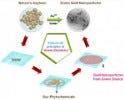'Pop and Go' Drug Delivery
Originally Published MDDI June 2002MEDICAL DESIGN EXCELLENCE AWARDS 2002 Duplex Drug Delivery SystemSubmitted and manufactured by B. Braun Medical Inc. (Irvine, CA)
June 1, 2002
Originally Published MDDI June 2002
MEDICAL DESIGN EXCELLENCE AWARDS 2002
Duplex Drug Delivery System
Submitted and manufactured by B. Braun Medical Inc. (Irvine, CA)

What makes the Duplex Drug Delivery System stand out in the drug-delivery marketplace? "In one sentence: Nurses love it!" Theodore Young, senior engineering specialist with B. Braun Medical Inc., says with a laugh. "Isn't that what it's all about? Designing products your customers will love." Indeed, during the product's launch last year, nurses declined in-depth training, noting that the product is so intuitive, "so easy."
The nurses were referring to the seals that make Duplex so different from traditional intravenous antibiotic-delivery systems that provide frozen, premixed solution or require mixing the powdered drug in the diluent bag. Frozen systems require a thawing period and added time before patient delivery (during which the drug's potency may be compromised). Other systems provide a means of docking a vial of powdered drug to a diluent-filled bag, which requires complex manipulation to mix the two components effectively. Sometimes the drug is not properly mixed with the diluent, resulting in the patient receiving less than a full dose.
|
Simple to use, the Duplex system ensures that patients receive drugs at full potency by combining powder and diluent in one package. |
Duplex strives to eliminate these challenges through the use of a customizable, multicompartment, flexible-plastic IV container that stores a unit dose of diluent and one of drug powder separately in the same package. The components are mixed at the bedside, ensuring that the patient gets the full potency of the drug. First, one seal is opened, which mixes the drug with the diluent. The bag is then given a little shake to complete the mixing process. Then the second seal is opened, and the bag is hung on the IV pole, ready for dispensing to begin.
"The concept of temporary seals in packaging is not unique, but this application is," Young explains. "We've developed a process that allows us to make seals that will survive the rigors of manufacturing and distribution, yet still be easy to peel so that customers can activate the system."
Both the seal technology itself and the material from which the seals are constructed came from other B. Braun products. "Years ago, we were developing another product and we had problems with the seals being less than permanent," Young recalls. "We started to think about how we could use these seals that peeled open in another application."
When they decided to apply the technology to a drug-delivery system, the first challenge was finding a material that would work. Many materials were tested, but again, another B. Braun product assisted. A material made of polypropylene blended with thermoplastic elastomer that had a workable process window (±2°F) fit the bill.
B. Braun engineers prevent moisture from entering the package by laminating aluminum foil to the base material. The seals are then closed—temporarily—through a hot-bar sealing process.
"We use a custom-built machine to press heated bars against the film to form the seal," Young says, adding that B. Braun created the prototype machine and developed the process, then worked with a custom-machine builder to construct the production equipment. The machine transforms molded parts and rolls of material into containers.
"Significant design effort went into the heat-seal station to ensure uniformity of the peelable seals," Young notes. "The process relies on repeatable time, temperature, and pressure inputs to produce seals. Custom machinery also was developed to aseptically fill the bags with powdered drug and liquid diluent."
By thinking of new ways to use proprietary technologies, and incorporating new manufacturing processes, B. Braun has developed a drug-delivery system that improves safety by ensuring proper dose delivery, that eliminates wasted product, and that minimizes labor—a combination that makes both the manufacturer and its customers happy, Young concludes.
Copyright ©2002 Medical Device & Diagnostic Industry
You May Also Like

.png?width=300&auto=webp&quality=80&disable=upscale)

